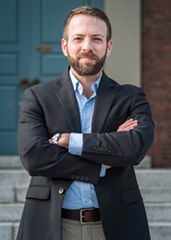The benefits
Dromi’s course aims to “sensitize students to the fact that philanthropy is a complex economic and social activity.” Touring different sites on campus and engaging with specialists and administrators in a variety of offices brings the course content to life. For example, when visiting Widener Library, students view archival materials highlighting the longstanding relationship between the University and the Widener family—and the relationship’s associated challenges. “The Harvard University Archives are a big part in making this happen. They set up the materials and guide students through them.” Additionally, Dromi has found that the visits and the changes in scenery help keep students motivated.
“In thinking about how to make the course more vivid for students, I started thinking about the sites that they would recognize, and perhaps how students might be interested in seeing them from a new light.”
The challenges
Dromi notes that coordinating the visits is not too taxing on faculty, but that instructors should be deliberate about planning the takeaways for students and providing space for students to unpack what they’ve learned on a visit. Students often get “sucked into the story” without connecting those narratives back to the course themes, so it is crucial that the instructor provides space for the students to tie the experience to their classroom learning.
Takeaways and best practices
-
Make the cold call. Dromi was surprised by how eager different offices were to partner with his courses. He notes that some of the most engaging connections were ones he wouldn’t have anticipated.
-
Contextualize the visits for students. To ensure the connections to coursework and the takeaways from a visit are clear for students, instructors should be sure to take time to contextualize the trip or guest speaker’s discussion with course themes. Dromi assigns relevant readings for students to review prior to visiting spaces.
-
Introduce students to new spaces. In coordinating these collaborations, Dromi has learned that students do not always explore campus on their own. For example, this course is often students’ first visit to Widener Library or encounter with the University Archives.
Bottom line
Partnering with and visiting different University offices and organizations can motivate students and provide vivid examples of course content coming to life in their own community.
 Shai Dromi, Associate Senior Lecturer on Sociology (FAS), teaches courses on philanthropy, activism, and collective identity. Dromi frequently incorporates active learning exercises and collaborations into his courses. In his undergraduate course, Philanthropy and the Nonprofit Sector, he partners with a wide variety of Harvard offices, including Widener Library, the Department of Athletics, and the Harvard College Fund, to showcase examples of the course content. He finds that “Harvard is full of… pockets of people who are really excited to have people come visit them” and that students benefit pedagogically from getting to know their campus community better.
Shai Dromi, Associate Senior Lecturer on Sociology (FAS), teaches courses on philanthropy, activism, and collective identity. Dromi frequently incorporates active learning exercises and collaborations into his courses. In his undergraduate course, Philanthropy and the Nonprofit Sector, he partners with a wide variety of Harvard offices, including Widener Library, the Department of Athletics, and the Harvard College Fund, to showcase examples of the course content. He finds that “Harvard is full of… pockets of people who are really excited to have people come visit them” and that students benefit pedagogically from getting to know their campus community better.
